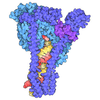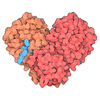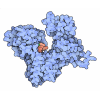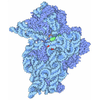+ Open data
Open data
- Basic information
Basic information
| Entry | Database: PDB / ID: 7thm | |||||||||||||||||||||
|---|---|---|---|---|---|---|---|---|---|---|---|---|---|---|---|---|---|---|---|---|---|---|
| Title | SARS-CoV-2 nsp12/7/8 complex with a native N-terminus nsp9 | |||||||||||||||||||||
 Components Components |
| |||||||||||||||||||||
 Keywords Keywords | VIRAL PROTEIN / polymerase / NiRAN / capping / nsp9 | |||||||||||||||||||||
| Function / homology |  Function and homology information Function and homology informationprotein guanylyltransferase activity / RNA endonuclease activity producing 3'-phosphomonoesters, hydrolytic mechanism / mRNA guanylyltransferase activity / 5'-3' RNA helicase activity / Lyases; Phosphorus-oxygen lyases / Assembly of the SARS-CoV-2 Replication-Transcription Complex (RTC) / symbiont-mediated suppression of host cytoplasmic pattern recognition receptor signaling pathway via inhibition of TBK1 activity / Maturation of replicase proteins / TRAF3-dependent IRF activation pathway / ISG15-specific peptidase activity ...protein guanylyltransferase activity / RNA endonuclease activity producing 3'-phosphomonoesters, hydrolytic mechanism / mRNA guanylyltransferase activity / 5'-3' RNA helicase activity / Lyases; Phosphorus-oxygen lyases / Assembly of the SARS-CoV-2 Replication-Transcription Complex (RTC) / symbiont-mediated suppression of host cytoplasmic pattern recognition receptor signaling pathway via inhibition of TBK1 activity / Maturation of replicase proteins / TRAF3-dependent IRF activation pathway / ISG15-specific peptidase activity / Transcription of SARS-CoV-2 sgRNAs / snRNP Assembly / Translation of Replicase and Assembly of the Replication Transcription Complex / Replication of the SARS-CoV-2 genome / Hydrolases; Acting on ester bonds; Exoribonucleases producing 5'-phosphomonoesters / double membrane vesicle viral factory outer membrane / host cell endoplasmic reticulum-Golgi intermediate compartment / SARS coronavirus main proteinase / 5'-3' DNA helicase activity / 3'-5'-RNA exonuclease activity / host cell endosome / symbiont-mediated degradation of host mRNA / mRNA guanylyltransferase / symbiont-mediated suppression of host ISG15-protein conjugation / symbiont-mediated suppression of host toll-like receptor signaling pathway / G-quadruplex RNA binding / symbiont-mediated suppression of host cytoplasmic pattern recognition receptor signaling pathway via inhibition of IRF3 activity / omega peptidase activity / mRNA (guanine-N7)-methyltransferase / methyltransferase cap1 / SARS-CoV-2 modulates host translation machinery / host cell Golgi apparatus / symbiont-mediated suppression of host NF-kappaB cascade / DNA helicase / symbiont-mediated perturbation of host ubiquitin-like protein modification / methyltransferase cap1 activity / ubiquitinyl hydrolase 1 / cysteine-type deubiquitinase activity / mRNA 5'-cap (guanine-N7-)-methyltransferase activity / Hydrolases; Acting on peptide bonds (peptidases); Cysteine endopeptidases / single-stranded RNA binding / regulation of autophagy / viral protein processing / lyase activity / host cell perinuclear region of cytoplasm / host cell endoplasmic reticulum membrane / RNA helicase / symbiont-mediated suppression of host type I interferon-mediated signaling pathway / symbiont-mediated suppression of host gene expression / copper ion binding / viral translational frameshifting / symbiont-mediated activation of host autophagy / RNA-directed RNA polymerase / cysteine-type endopeptidase activity / viral RNA genome replication / RNA-directed RNA polymerase activity / DNA-templated transcription / lipid binding / host cell nucleus / SARS-CoV-2 activates/modulates innate and adaptive immune responses / ATP hydrolysis activity / proteolysis / RNA binding / zinc ion binding / ATP binding / membrane Similarity search - Function | |||||||||||||||||||||
| Biological species |  | |||||||||||||||||||||
| Method | ELECTRON MICROSCOPY / single particle reconstruction / cryo EM / Resolution: 3.18 Å | |||||||||||||||||||||
 Authors Authors | Osinski, A. / Tagliabracci, V.S. / Chen, Z. / Li, Y. | |||||||||||||||||||||
| Funding support |  United States, 4items United States, 4items
| |||||||||||||||||||||
 Citation Citation |  Journal: Nature / Year: 2022 Journal: Nature / Year: 2022Title: The mechanism of RNA capping by SARS-CoV-2. Authors: Gina J Park / Adam Osinski / Genaro Hernandez / Jennifer L Eitson / Abir Majumdar / Marco Tonelli / Katie Henzler-Wildman / Krzysztof Pawłowski / Zhe Chen / Yang Li / John W Schoggins / ...Authors: Gina J Park / Adam Osinski / Genaro Hernandez / Jennifer L Eitson / Abir Majumdar / Marco Tonelli / Katie Henzler-Wildman / Krzysztof Pawłowski / Zhe Chen / Yang Li / John W Schoggins / Vincent S Tagliabracci /    Abstract: The RNA genome of SARS-CoV-2 contains a 5' cap that facilitates the translation of viral proteins, protection from exonucleases and evasion of the host immune response. How this cap is made in SARS- ...The RNA genome of SARS-CoV-2 contains a 5' cap that facilitates the translation of viral proteins, protection from exonucleases and evasion of the host immune response. How this cap is made in SARS-CoV-2 is not completely understood. Here we reconstitute the N7- and 2'-O-methylated SARS-CoV-2 RNA cap (GpppA) using virally encoded non-structural proteins (nsps). We show that the kinase-like nidovirus RdRp-associated nucleotidyltransferase (NiRAN) domain of nsp12 transfers the RNA to the amino terminus of nsp9, forming a covalent RNA-protein intermediate (a process termed RNAylation). Subsequently, the NiRAN domain transfers the RNA to GDP, forming the core cap structure GpppA-RNA. The nsp14 and nsp16 methyltransferases then add methyl groups to form functional cap structures. Structural analyses of the replication-transcription complex bound to nsp9 identified key interactions that mediate the capping reaction. Furthermore, we demonstrate in a reverse genetics system that the N terminus of nsp9 and the kinase-like active-site residues in the NiRAN domain are required for successful SARS-CoV-2 replication. Collectively, our results reveal an unconventional mechanism by which SARS-CoV-2 caps its RNA genome, thus exposing a new target in the development of antivirals to treat COVID-19. #1: Journal: Res Sq / Year: 2022 Title: The mechanism of RNA capping by SARS-CoV-2. Authors: Gina J Park / Adam Osinski / Genaro Hernandez / Jennifer L Eitson / Abir Majumdar / Marco Tonelli / Katie Henzler-Wildman / Krzysztof Pawłowski / Zhe Chen / Yang Li / John W Schoggins / ...Authors: Gina J Park / Adam Osinski / Genaro Hernandez / Jennifer L Eitson / Abir Majumdar / Marco Tonelli / Katie Henzler-Wildman / Krzysztof Pawłowski / Zhe Chen / Yang Li / John W Schoggins / Vincent S Tagliabracci /   Abstract: The SARS-CoV-2 RNA genome contains a 5'-cap that facilitates translation of viral proteins, protection from exonucleases and evasion of the host immune response1-4. How this cap is made is not ...The SARS-CoV-2 RNA genome contains a 5'-cap that facilitates translation of viral proteins, protection from exonucleases and evasion of the host immune response1-4. How this cap is made is not completely understood. Here, we reconstitute the SARS-CoV-2 7MeGpppA2'-O-Me-RNA cap using virally encoded non-structural proteins (nsps). We show that the kinase-like NiRAN domain5 of nsp12 transfers RNA to the amino terminus of nsp9, forming a covalent RNA-protein intermediate (a process termed RNAylation). Subsequently, the NiRAN domain transfers RNA to GDP, forming the cap core structure GpppA-RNA. The nsp146 and nsp167 methyltransferases then add methyl groups to form functional cap structures. Structural analyses of the replication-transcription complex bound to nsp9 identified key interactions that mediate the capping reaction. Furthermore, we demonstrate in a reverse genetics system8 that the N-terminus of nsp9 and the kinase-like active site residues in the NiRAN domain are required for successful SARS-CoV-2 replication. Collectively, our results reveal an unconventional mechanism by which SARS-CoV-2 caps its RNA genome, thus exposing a new target in the development of antivirals to treat COVID-19. | |||||||||||||||||||||
| History |
|
- Structure visualization
Structure visualization
| Movie |
 Movie viewer Movie viewer |
|---|---|
| Structure viewer | Molecule:  Molmil Molmil Jmol/JSmol Jmol/JSmol |
- Downloads & links
Downloads & links
- Download
Download
| PDBx/mmCIF format |  7thm.cif.gz 7thm.cif.gz | 391.1 KB | Display |  PDBx/mmCIF format PDBx/mmCIF format |
|---|---|---|---|---|
| PDB format |  pdb7thm.ent.gz pdb7thm.ent.gz | 317.1 KB | Display |  PDB format PDB format |
| PDBx/mmJSON format |  7thm.json.gz 7thm.json.gz | Tree view |  PDBx/mmJSON format PDBx/mmJSON format | |
| Others |  Other downloads Other downloads |
-Validation report
| Summary document |  7thm_validation.pdf.gz 7thm_validation.pdf.gz | 891 KB | Display |  wwPDB validaton report wwPDB validaton report |
|---|---|---|---|---|
| Full document |  7thm_full_validation.pdf.gz 7thm_full_validation.pdf.gz | 896.4 KB | Display | |
| Data in XML |  7thm_validation.xml.gz 7thm_validation.xml.gz | 34.2 KB | Display | |
| Data in CIF |  7thm_validation.cif.gz 7thm_validation.cif.gz | 52.2 KB | Display | |
| Arichive directory |  https://data.pdbj.org/pub/pdb/validation_reports/th/7thm https://data.pdbj.org/pub/pdb/validation_reports/th/7thm ftp://data.pdbj.org/pub/pdb/validation_reports/th/7thm ftp://data.pdbj.org/pub/pdb/validation_reports/th/7thm | HTTPS FTP |
-Related structure data
| Related structure data |  25898MC M: map data used to model this data C: citing same article ( |
|---|---|
| Similar structure data |
- Links
Links
- Assembly
Assembly
| Deposited unit | 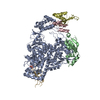
|
|---|---|
| 1 |
|
- Components
Components
-Protein , 1 types, 1 molecules A
| #1: Protein | Mass: 106780.977 Da / Num. of mol.: 1 / Fragment: UNP residues 4393-5324 Source method: isolated from a genetically manipulated source Source: (gene. exp.)  Gene: rep, 1a-1b / Production host:  |
|---|
-Non-structural protein ... , 3 types, 4 molecules BDCG
| #2: Protein | Mass: 21903.047 Da / Num. of mol.: 2 Source method: isolated from a genetically manipulated source Source: (gene. exp.)  Gene: rep, 1a-1b / Production host:  #3: Protein | | Mass: 9248.804 Da / Num. of mol.: 1 Source method: isolated from a genetically manipulated source Source: (gene. exp.)  Gene: rep, 1a-1b / Production host:  #4: Protein | | Mass: 12391.171 Da / Num. of mol.: 1 Source method: isolated from a genetically manipulated source Source: (gene. exp.)  Gene: rep, 1a-1b / Production host:  |
|---|
-Non-polymers , 3 types, 4 molecules 

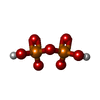


| #5: Chemical | | #6: Chemical | ChemComp-MN / | #7: Chemical | ChemComp-POP / | |
|---|
-Details
| Has ligand of interest | Y |
|---|---|
| Has protein modification | N |
-Experimental details
-Experiment
| Experiment | Method: ELECTRON MICROSCOPY |
|---|---|
| EM experiment | Aggregation state: PARTICLE / 3D reconstruction method: single particle reconstruction |
- Sample preparation
Sample preparation
| Component | Name: SARS-CoV-2 replication-transcription complex with a native N-terminus nsp9 bound to NiRAN domain of nsp12. Type: COMPLEX / Entity ID: #1-#4 / Source: RECOMBINANT | |||||||||||||||||||||||||
|---|---|---|---|---|---|---|---|---|---|---|---|---|---|---|---|---|---|---|---|---|---|---|---|---|---|---|
| Molecular weight | Value: 0.17203949 MDa / Experimental value: NO | |||||||||||||||||||||||||
| Source (natural) | Organism:  | |||||||||||||||||||||||||
| Source (recombinant) | Organism:  | |||||||||||||||||||||||||
| Buffer solution | pH: 7.5 | |||||||||||||||||||||||||
| Buffer component |
| |||||||||||||||||||||||||
| Specimen | Conc.: 2 mg/ml / Embedding applied: NO / Shadowing applied: NO / Staining applied: NO / Vitrification applied: YES | |||||||||||||||||||||||||
| Vitrification | Instrument: FEI VITROBOT MARK IV / Cryogen name: ETHANE |
- Electron microscopy imaging
Electron microscopy imaging
| Experimental equipment |  Model: Titan Krios / Image courtesy: FEI Company |
|---|---|
| Microscopy | Model: TFS KRIOS |
| Electron gun | Electron source:  FIELD EMISSION GUN / Accelerating voltage: 300 kV / Illumination mode: FLOOD BEAM FIELD EMISSION GUN / Accelerating voltage: 300 kV / Illumination mode: FLOOD BEAM |
| Electron lens | Mode: BRIGHT FIELD / Nominal defocus max: 2500 nm / Nominal defocus min: 1000 nm |
| Image recording | Electron dose: 54 e/Å2 / Film or detector model: GATAN K3 BIOQUANTUM (6k x 4k) |
- Processing
Processing
| Software | Name: PHENIX / Version: 1.19.2_4158: / Classification: refinement | ||||||||||||||||||||||||
|---|---|---|---|---|---|---|---|---|---|---|---|---|---|---|---|---|---|---|---|---|---|---|---|---|---|
| EM software | Name: PHENIX / Category: model refinement | ||||||||||||||||||||||||
| CTF correction | Type: PHASE FLIPPING AND AMPLITUDE CORRECTION | ||||||||||||||||||||||||
| 3D reconstruction | Resolution: 3.18 Å / Resolution method: FSC 0.143 CUT-OFF / Num. of particles: 39985 / Symmetry type: POINT | ||||||||||||||||||||||||
| Refine LS restraints |
|
 Movie
Movie Controller
Controller










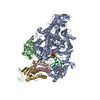
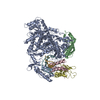
 PDBj
PDBj